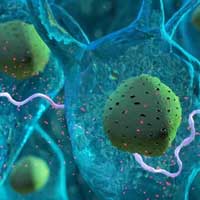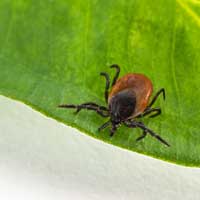Chronic Lyme Disease's Parasitic Coinfection Babesiosis

Intraerythrocytic parasite Babesia microiti causes Babesiosis, an infection that dwells inside red blood cells. Through asexual budding, the parasite reproduces within the blood cells themselves. It is transmitted by the same tick that transmits B. burgdorferi, the causative agent of Lyme disease.
The first case of human babesiosis was reported in Europe in 1957, and since that time, 28 more human cases have been reported throughout Europe. 83 percent of the infections occurred in asplenic individuals and 76 percent of them were infected by babesia divergens, a cattle parasite. Parsitaemias varied from 1 to 80 percent of the red blood cells and the clinical manifestations of severe b. divergens infection were intravascular haemolysis with haemoglobinuria. The most effective treatment was initiated with a massive blood transfusion and then immediately followed by clindamycin chemotherapy.
Parasites in the United States
Unlike Europe, hundreds of cases of babesia spp. have been reported in the U.S.A. Most infections were the result of tick bites carrying the rodent parasite b. microti. That being said, it does seem that other infections are emerging related to babesia spp. (also known as WA1, CA1, and MO1). Incredibly, some of the infections were the result of contaminated blood transfusions. The clinical manifestations ran the gamut from asymptomatic to rapidly fatal.
Similar to the European reports, parasitaemia ranged between 1 and 85 percent of the blood cells. The splenectomized, the elderly, the immunocompromised and HIV-infected patients were predisposed to severe infection. We also consider that those patients suffering with chronic Lyme disease complex to be immune compromised as well. Infections with B. microti often remained subclinical or asymptomatic and were only detected through serological surveys.
Babesiosis Symptoms are Similar to Lyme
Babesiosis is rarely tested for, and, as a result, many sufferers are misdiagnosed with an autoimmune or chronic disease with similar symptomology. Those who are misdiagnosed continue to endure their illness as they are not administered the proper treatment.
The disease may manifest more severely with advanced age, splenectomy, and immunodeficient states. Symptoms include but are not limited to high fever, chills, diaphoresis, weakness, anorexia, and headache. As the course of the illness lengthens, the patient may develop jaundice in addition to congestive heart failure, acute respiratory distress syndrome, and renal failure.
Tick-Borne Babesia Parasite - Another Infectious Contributor to Lyme Disease Complex
Transmitted by ticks, babesia parasites are an emerging zoonotic disease and are among the most widespread blood parasites in the world. As a result, their widespread economic, medical and veterinary impacts are considerable across the globe. These intraerythrocytic pear-shaped "piroplasms" are passed along by ixodid ticks and can infect scores of vertebrate hosts suited to maintain the transmission cycle.
By studying non-human animals and their experiences with the parasite, we have gained much understanding of the disease process, the parasite's pathogenic mechanisms, as well as how the hosts respond to its infection.
Babesia microti is the most prevalent strain to inhabit humans in the U.S., whereas B. microti is far more common throughout Europe. The spectrum of disease manifestation (common associated symptoms) can run the gamut from an entirely silent infection to a malaria-like disease, and in some cases, even death. At least now there are several highly-sensitive diagnostics to facilitate proper diagnosis – an invaluable step for patient care and effective treatment.
Untreated Babesia Can Lead to Cardiovascular Issues
41 percent of patients dealing with Babesia develop serious complications including acute respiratory failure, disseminated intravascular coagulation, congestive heart or renal failure. Complex babesiosis is regularly associated with the presence of severe anemia and high parasitaemia levels. Chronic babesia has been known to trigger cardiovascular, kidney and liver problems in patients.
Importance of Immune System and Cytokine in Babesia Etiology
Babesia microti infections in mice were investigated with regard to Helper T cell cytokine as well as antibody responses. It turns out that Th1 cytokines dominated the early inflammatory response and likely served to control acute parasitaemia. Th-2 responses could be a means by which parasitic reduction or elimination from the body could occur. Expressions of IL-4 and IL-10 might be critical to the immune system for the patients' complete return to health. Patients whose immune systems remain compromised may continue indefinitely in the inflammatory/chronic inflammatory phase, putting them at an increased risk for cardiovascular problems and cancer.
Doctor and author Hulda Clark was considered a quack for her first cancer book, "The Cure for All Cancers," where she examined and outlined the causes of malignancy. The doctor was extremely specific about causatives as well as measures to take to rid the body of them. One part of her process was to begin and maintain a parasite killing program while inhabiting a consistently clean environment to allow the immune system to function at a high level. A decade later, we see the importance of the immune system in treating all infections being completely invaluable to the recovery of cancer and chronic disease patients.
Macrophage and Immunity for Long-Term Babesia Parasite Removal
While the mechanism of cross-infection has yet to be determined, mice with a Babesia microti primary infection seemingly protected them from a subsequently lethal Babesia rodhaini infection. Study results seem to indicate that macrophages contribute to the protection against this challenging parasitic infection.
Babesiosis is one of the many infections that Envita tests for in patients, as part of our Disease Solutions Program®. Through our extensive testing and state-of-the-art diagnostic tools, we ensure that patients do not suffer needlessly, resultant of misdiagnoses. Envita uses the best of conventional and natural medicine to diagnose and treat a range of infections and diseases such as Babesiosis.























